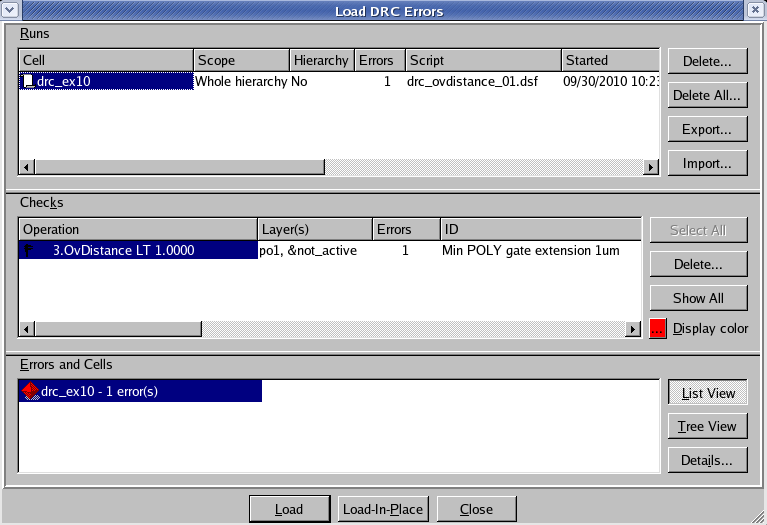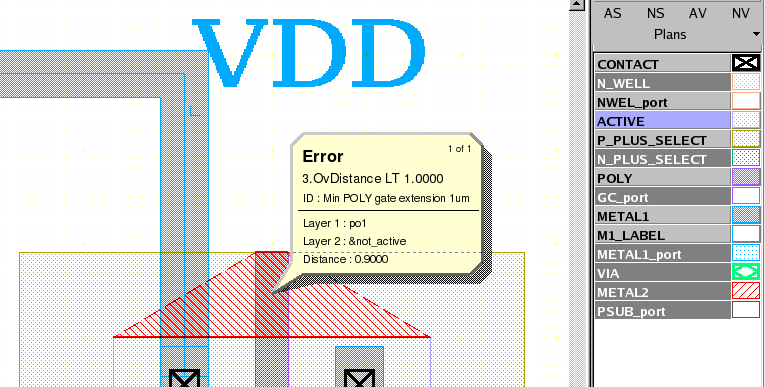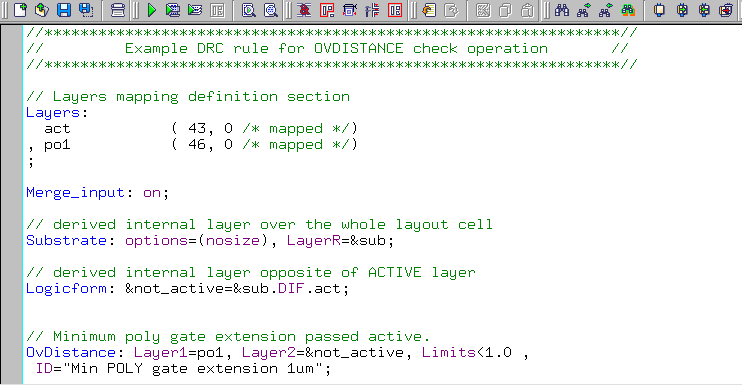004_ovdistance : OvDistance Operation
Minimum Required Version
: Expert 4.14.0.R, Guardian 4.14.0.R
This example will demonstrate how the Guardian DRC tool can be used to measure the OvDistance (overlapping distance) of layout objects.
1. Preliminary steps
To run this example, open a Guardian DRC session and choose File->Open to load the project "drc_ex10.eld" . Then open the top cell drc_ex10 using the Cell->Open... menu.
2. OvDistance command for error detection
Some DRC rules require an overlap measurement of two different layers. For example, for a given device it may be necessary to have the NWELL layer going under the gate area by a minimum of 30nm. This type of rule can be implement using the OvDistance command.
OvDistance is used to measure the admissible distance between the inner surfaces of sides of regions from the first input layer, and the inner surfaces of sides of regions from the second input layer.
The syntax for this rule is:
OvDistance: Layer1= < input layer identifier1 >,
Layer2= < input layer identifier2 >,
Value= < value >, Type= < check type >,
LayerR1= < result layer identifier1 >,
LayerR2= < result layer identifier2 >,
Options = (list of check options),
ID = < error identifier >;
in which:
- Layer1 is the first layer name being measured
- Layer2 is the second layer name being measured
- Value is the value in um of the measurement
- Type can be greater than, less than, (>, <, ==, !=, ...)
- LayerR1 is the layer name in which the geometries of layer1 in violation of the rule would be saved
- LayerR2 is the layer name in which the geometries of layer2 in violation of the rule would be saved
- Options is the list of additional option to the check
- ID is the error message that would be display and listed in the log when the error occur
Figure 1 illustrates the syntax that can be used to implement such a task.
A detailed description of all options that can be used for the different rules can be found in the Guardian DRC user manual section 2.3.9.1: Common Syntax: Parameters and Options. Section 2.3.9.7 describes the OvDistance command. The user manual "guardian_users1.pdf" can be found in lib/expert/4.14.0.R/docs/ in your installation area.
It is to be noted that some options are not allowed for certain DRC checks. For the "OvDistance" operation, the options: D, U, IS, N, N' ( Acute adjacency, Obtuse adjacency, Self intersecting, Notch, and Notch Only ) are not allowed.
3. Experimenting with the OvDistance command
Once all the example files have been downloaded and the preliminary steps described in 1.0 are completed, complete the following steps:
- Choose Verification->DRC->DRC Script panel . In this new window, choose File->Open... and select "drc_ovdistance_01.dsf".
- Press DRC->Run
- To inspect the errors, choose Verification->DRC->Errors->Load errors... you should get a window as shown in Figure 2.
- Select the check and press the Load button located at the bottom of the window. Then choose Verification->DRC->Errors->First error to display the error in the layout, as shown in Figure 3 .
- To unload the error choose Verification->DRC->Errors->Unload errors .
Note these two toolbars can be used to access the DRC menu command. To turn the visibility of the toolbar ON and OFF, choose View->Toolbars and select DRC and DRC error inspection.
Guardian DRC can also be launched from within the layout editor tool Expert. Within an Expert session follow the steps described in 1.0 to open the eld file. Then choose Verification->DRC->DRC Script panel. In this new window, choose File->Open... and select desired DRC script. The rest of the steps are identical to the Guardian DRC flow.
drc_ovdistance_01.dsf
//****************************************************************// // Example DRC rule for OVDISTANCE check operation // //****************************************************************// // Layers mapping definition section Layers: act ( 43, 0 /* mapped */) , po1 ( 46, 0 /* mapped */) ; Merge_input: on; // derived internal layer over the whole layout cell Substrate: options=(nosize), LayerR=⊂ // derived internal layer opposite of ACTIVE layer Logicform: ¬_active=&sub.DIF.act; // Minimum poly gate extension passed active. OvDistance: Layer1=po1, Layer2=¬_active, Limits<1.0 , ID="Min POLY gate extension 1um"; // END of DRC check





